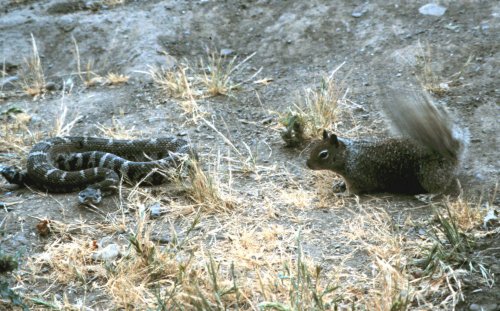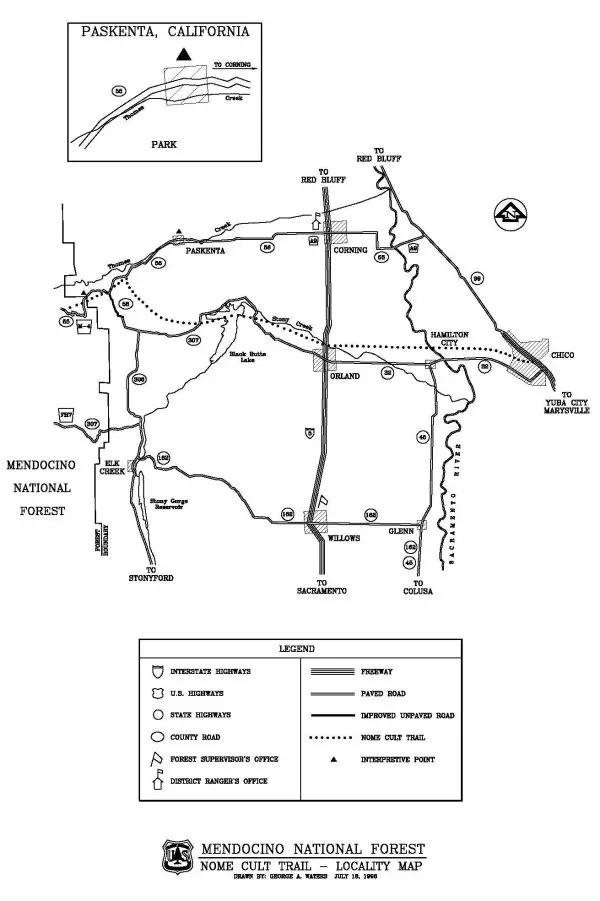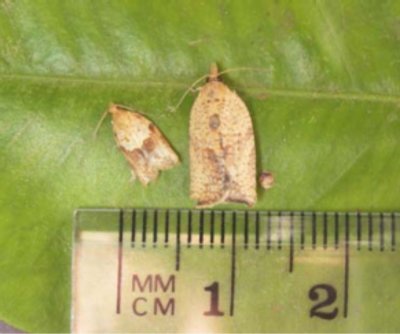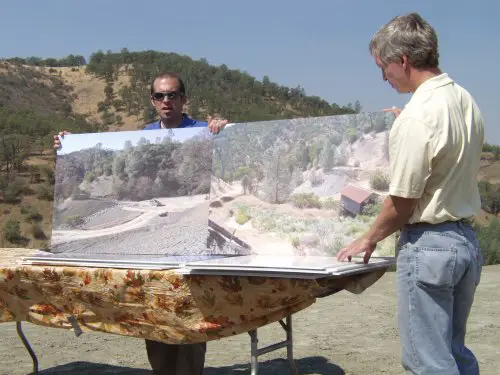
From left, Bob Cornez and Dale Evans show off before (right) and after pictures of the mine site. Photo by Elizabeth Larson.
ABBOTT MINE – A massive mine cleanup project of two south county mercury mines begun last fall officially wrapped on Thursday.
The Abbott and Turkey Run mines, minus the mountains of mine tailings and buildings that once marked the site along Highway 20 near Walker Ridge Road, were shown off Thursday by officials from El Paso Corp. of Colorado Springs, Colo., and the US Environmental Protection Agency.
The cleanup project began Oct. 10, 2006, said Clay Bowers, project manager for Camp, Dresser and McKee (CDM), the Cambridge, Mass.-based contractor that El Paso hired to complete the cleanup job.
Daniel Schnee, senior legal counsel for El Paso, said EPA's Region Nine Office, based in San Francisco, contacted El Paso in June 2006 to inquire if the company had ever conducted mining operations at the two mines.
El Paso's business is centered mostly in the southwest, where spokesman Richard Wheatley said they have some 43,000 miles of natural gas pipeline. That puts their current operations nowhere near Lake County.
However, Schnee said El Paso conducted an internal review and found that one of the subsidiaries it had purchased over the years, COG Minerals Corp., had, indeed, been responsible for mining operations at the site.
This wasn't the first mine cleanup El Paso has undertaken. Wheatley said the company also has been involved with cleanup of the famous Comstock Mine, which produced Nevada's silver Comstock Lode.
Schnee said the Abbott Mine claim was filed in 1866. There is some uncertainty about the Turkey Run's history, he added, although the company believes that the Turkey Run claim was filed in 1893. The two mines consolidated operations in 1900.
The mines were highly productive, yielding between 50,000 and 60,000 flasks of mercury during operation, which ceased in 1961, said Schnee. A flask is the size of a three-liter soda bottle and weighs 76 pounds.
The project gets started
Marc Ferries, El Paso's environmental remediation director, said the company was, at first, admittedly reluctant to spend the $5 million needed to carry out the cleanup.
However, he said El Paso's leadership decided it needed to be proactive and clean up the site, which also was in keeping with its corporate vision of being "the neighbor to have."
Schnee added that it came down to trust. "We are very conscious of the public's view of our company and our reputation means a lot to us."
By taking the lead on the project, El Paso also made a smart business decision financially.
EPA was poised to move forward with the cleanup, even if El Paso wasn't, said Schnee. Had the company chosen to contest its liability, Schnee said it would have resulted in an estimated cleanup cost three times the amount the company paid to do the work on its own.
So El Paso moved forward quickly, hiring CDM to lead the cleanup, said Schnee. El Paso Remediation Manager Bart Wilking; Janet Yocum, EPA's onsite coordinator; and Dale Evans of CDM, an expert in mine remediation, designed the project.
Schnee said work began only four months after EPA's initial contact with El Paso.
A unique factor to the cleanup is that El Paso, although held as a responsible party through its subsidiary holdings, doesn't actually own the property, said Schnee. There are now between four and six private owners who own the land through old mine patents passed down to them. Lake County News could not reach them for comment for this story.
El Paso had other challenges, said Evans, including unbelievably steep terrain, with grades as high as 52 degrees in some places.
And besides the mine they had to clean up 23 abandoned vehicles and tons of illegally dumped garbage, company officials reported.
There also was the matter of a squatter who had lived on the land for eight years and created a compound of sorts that included old trailers. Schnee said eventually the company reached a settlement with the man, who left.
Landscape a challenge
Pointing across the landscape, Evans said, "The terrain was obviously a challenge."
In some cases, it was a study in geometry, he said.
Much credit was given to CDM's heavy equipment operators, whose virtuoso skills on bulldozers helped carry out the work. Evans joked that the men were "part mountain goat"; so skilled were the operators that they were able to take the dozers down the incredibly steep slopes safely.
On the topic of safety, El Paso representatives on Thursday were very proud of the absence of any safety concerns or accidents as the project – which required 20,000 man hours – took place.
Evans explained that they removed tons of mine tailings – the waste left over after the mercury is extracted from the rock – from the hillsides and roads, including one mountain of tailings that had formed out from the natural hillside.
Bob Cornez, CDM's lead site construction supervisor, said they looked at the materials and judged whether they were leachable or nonleachable. If they were likely to leach mercury into the soil, those materials were removed completely, he said.
Mine tailings not considered a worry for leaching were capped with a 2-foot-thick layer of clean soil taken from nearby, Wilking said.
Materials considered to be hazardous were loaded, covered and trucked to a hazardous waste site in Nevada, said Wilking.
Cornez estimated that 50 truckloads of the hazardous materials were transported to Nevada.
The mine's buildings, 30-ton furnace and ore bins – the latter considered major contributors to the site's mercury contamination – were completely removed, said Cornez.
Evans said the wooden structures had soaked up mercury and were contaminated.
However, 10 pieces of metal mining equipment that could be decontaminated were saved, said Cornez.
The Lake County Historical Society received several pieces of equipment, according to Greg Dills, who chairs the Historical Society's committee on the Ely Stage Stop Museum, where the equipment eventually will be displayed.
Included was a large winch for raising and lowering people into the mine shafts, a smaller winch, a drag line and a cage used for the ore cars, said Dills. “It's some nice old historic equipment of Lake County's mining.”
Confronting water quality issues
One of the most important aspects of the project was to stop mercury escaping from the site and going into Harley Gulch, at the base of the hillside where the mine was located.
An estimated 10.2 kilograms of mercury in the form of sediment was eroding from the site each year into Harley Gulch, said Wilking. Evans added that Harley drains into Cache Creek about eight miles from the mines.
"We've isolated all that mine waste," said Wilking, with the goal that no more mercury will leach into Harley Gulch or Cache Creek.
That's an important goal; a 2002 report on the Cache Creek Watershed noted that Cache Creek was a major source of mercury to the Bay-Delta, which it drains into.
Wilking said the excavation went down as far as the gulch's flow line; today the gulch is thoroughly riprapped with rock brought from local quarries.
The project was intended to withstand a 100-year flood event, but Evans surmised it could survive much more – possibly a 500-year or 1,000-year event, due in part to the size of the riprap used to secure the site's drainages and creeks.
Evans said they tried to spare as much vegetation and as many trees as possible during the cleanup.
The four to five mine entries, leading to shafts that in some areas led as far as 500 feet into the mountainside, are all now filled and capped, Evans added.
Regulator, company worked well together
El Paso officials cited a great working relationship with EPA, a situation that isn't common between companies and regulators.
"I could not have imagined how good the final project was going to look," said Yocum, who added that the project will greatly benefit the environment.
On behalf of EPA, Yocum thanked El Paso for taking the lead and jumping ahead of EPA's processes. "At every level it's been a great team to work with."
A question company officials couldn't answer is how the site will be monitored going forward. That, said Schnee, has yet to be determined, and could involve not just El Paso but state and federal officials.
Abandoned mines are no small problem for Lake County. Ferries reported that there were 14 mercury mines in the county's Sulphur Bank district.
David Lawler, coordinator of the Bureau of Land Management's (BLM) Abandoned Mine Lands Program in the California state office, said BLM was currently assessing cleanups of about 10 mines in the county. Lawler estimated that there are 100 mercury mines around Lake County.
The reason, said Lawler, is California's rich mineral deposits. "California has world-class mercury deposits," he said, adding that the state is home to the five largest mercury mines in North America.
Supervisor Ed Robey, one of several visitors to the mine site Thursday, thanked El Paso officials for completing the project. In comparison, he said there has been an ongoing battle over the cleanup of the Sulphur Bank mine.
That mine, which is owned by Bradley Mining, is an EPA Superfund site. Last year EPA completed the first phase of its cleanup of the site, which took place at the Elem Colony.
E-mail Elizabeth Larson at This email address is being protected from spambots. You need JavaScript enabled to view it..
{mos_sb_discuss:2}
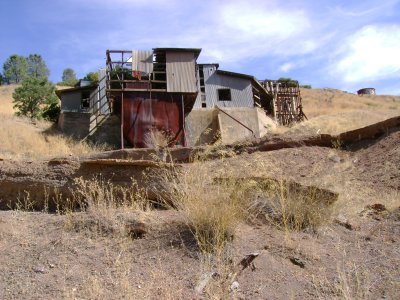
The processing buildings at the Abbott Mine. The buildings have since been removed. Courtesy photo.
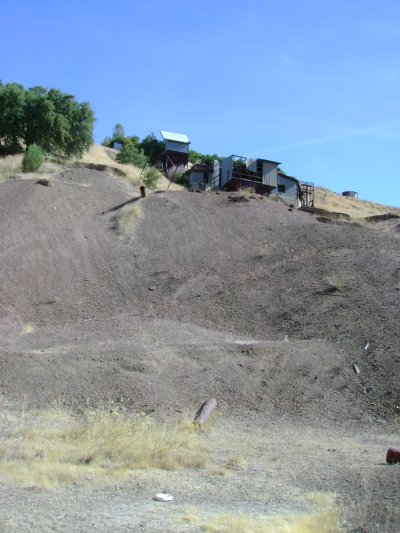
The Abbott Mine buildings sitting on a pile of tailings. Both the buildings and the tailings have been removed. Courtesy photo.

A gigantic pile of mine tailings that was visible from Highway 20. The project cleaned up the pile. Courtesy photo.
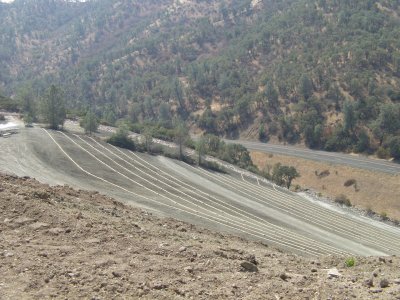
A view of one of the hillsides where tailings have been carved away. Photo by Elizabeth Larson.
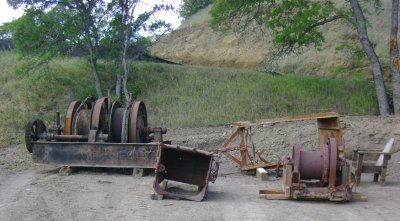
Some of the old mining equipment recovered from the mine. Courtesy photo.






